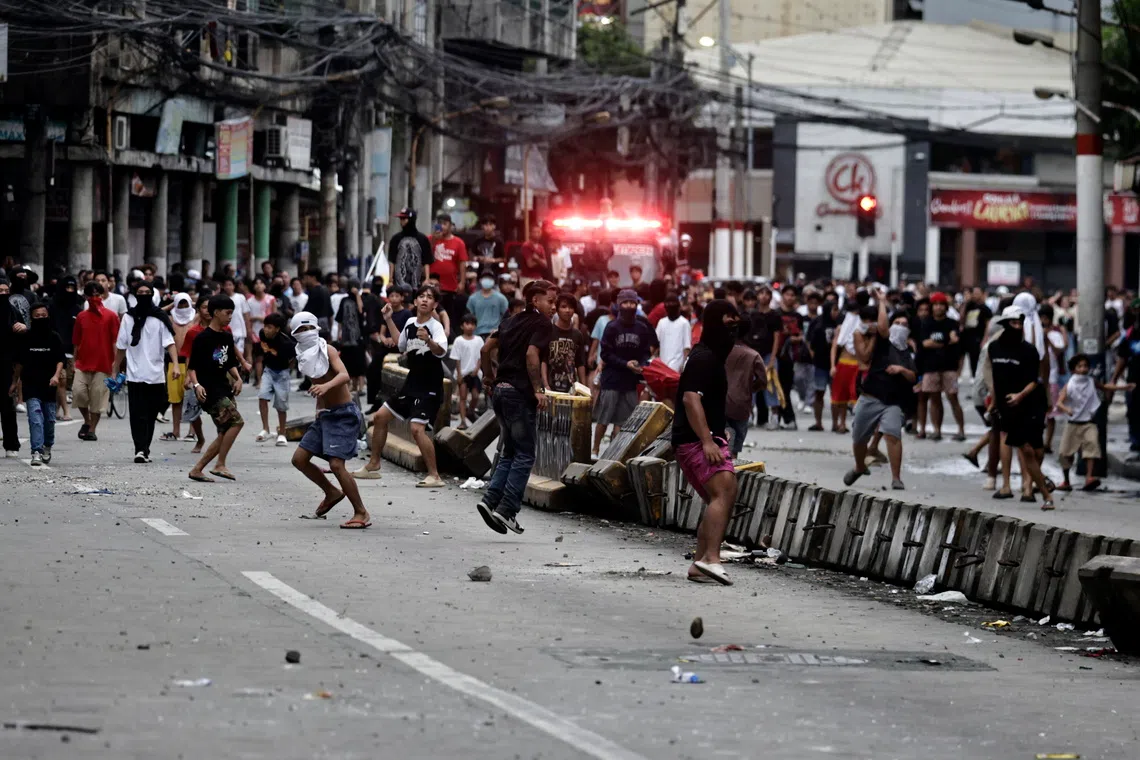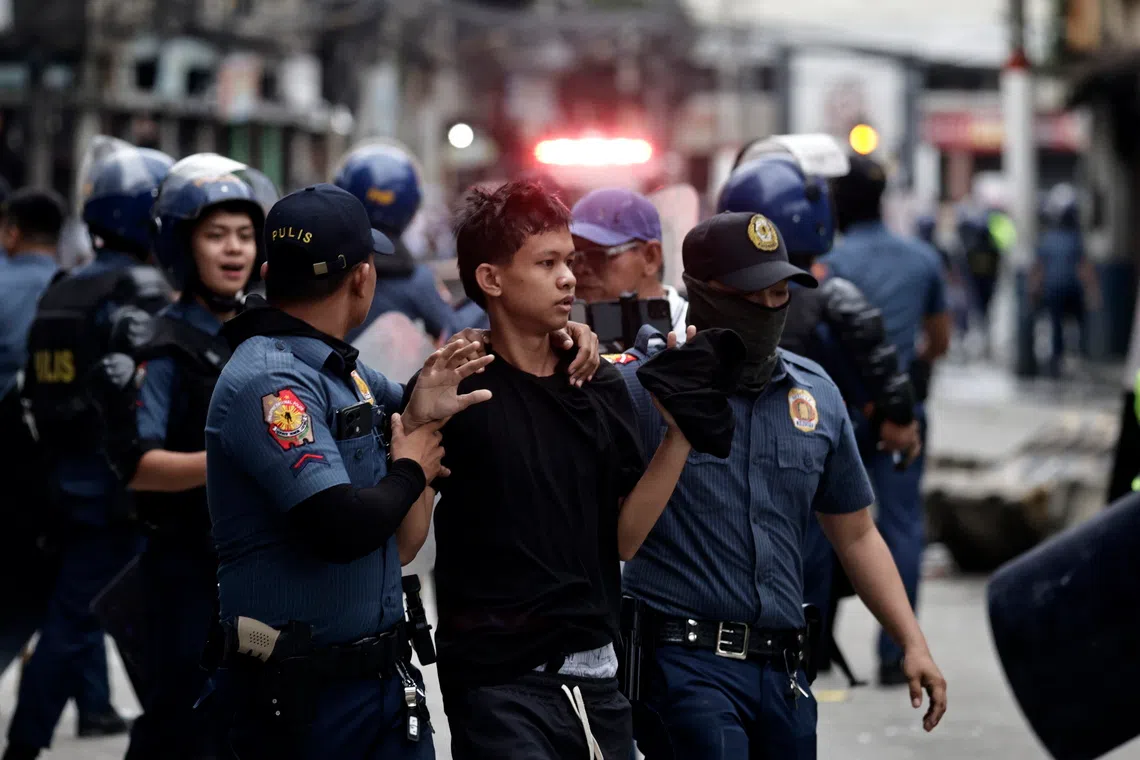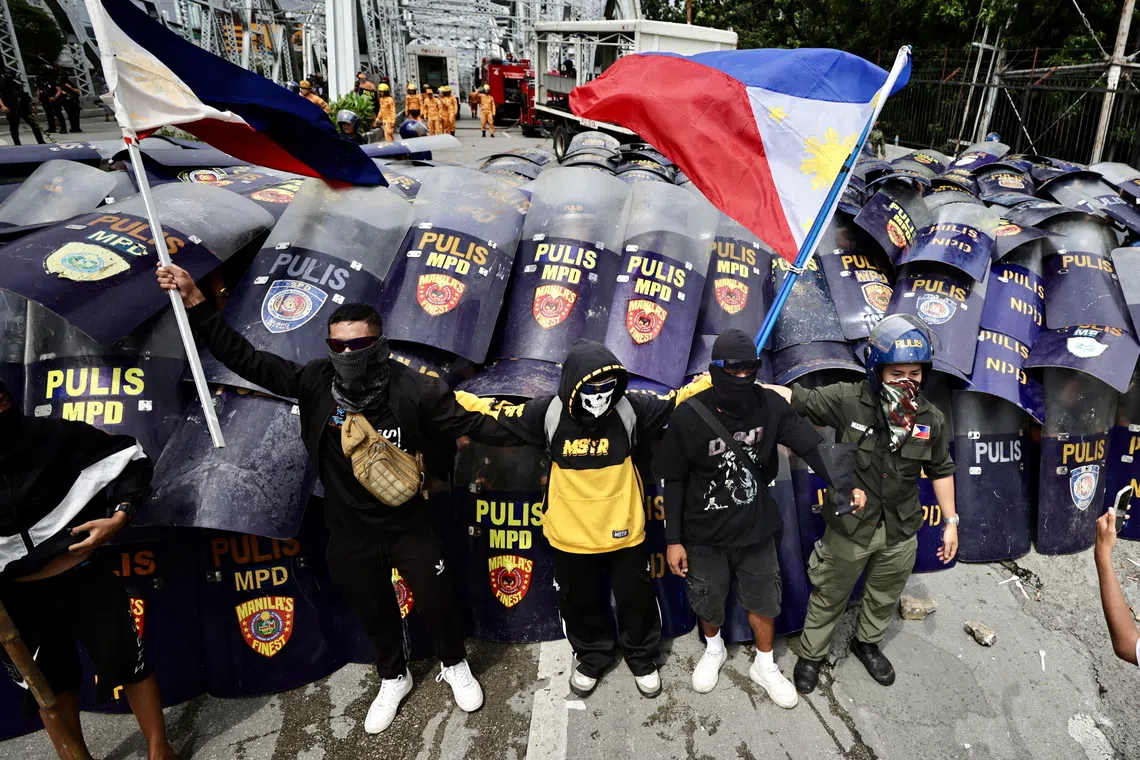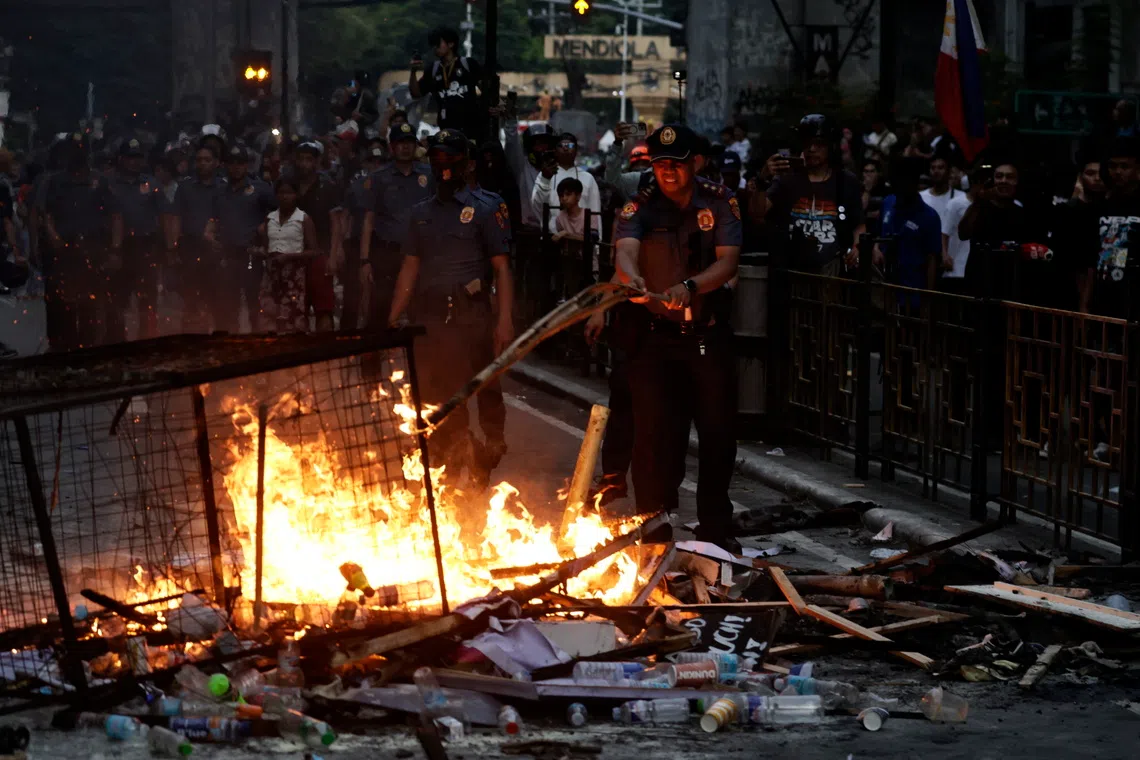‘Return our stolen money’: Filipinos protest flood control corruption in show of force
Sign up now: Get ST's newsletters delivered to your inbox
Follow topic:
- Filipinos protested against corruption, mirroring the 1986 People Power revolution, after reports of anomalies in a flood control budget of 1.9 trillion pesos.
- Protesters demanded accountability and the recovery of stolen funds, triggered by investigations into "ghost" infrastructure projects.
- The protests united diverse groups, symbolising defiance against corruption and echoing the fight against the Marcos Sr dictatorship.
AI generated
MANILA – A sea of black and white swept through Philippine capital Manila and neighbouring Quezon City on Sept 21, as more than 100,000 Filipinos gathered in a generally peaceful protest against corruption – echoing the spirit of the bloodless revolution that toppled a dictator in 1986.
The demonstrations were a defiant response to the alleged siphoning of public funds through “ghost” infrastructure projects tied to flood control.
Protesters condemned lawmakers, construction firm owners and public works officials currently being investigated by the government for allegedly pocketing huge sums meant to protect communities from rising waters.
Ironically, the probe that sparked the protests was ordered by President Ferdinand Marcos Jr – the son of the late strongman Ferdinand Marcos Sr, who was deposed in 1986 during the peaceful People Power uprising.
President Marcos vowed that the investigation would spare “no sacred cows” after reports emerged of anomalies in the 1.9 trillion peso (S$42.6 billion) flood control budget in the last 15 years.
The demonstrations stretched from Luneta Park in Manila to the People Power Monument in Quezon City, with the participants decrying what they described as institutionalised theft and political patronage disguised as public works.
Many of them were young Filipinos, who told The Straits Times they were fed up with “rotten corruption” that has plagued the government.
The protest colour of white stands for unity and hope, while black is a sign of defiance.
“We are inheriting this country some day. How can we thrive under a corrupt government?” medical student Paolo Chaves, 24, of the University of the Philippines-Manila, told ST. “We are tired of this rotten system.”
Many protesters carried placards that read “Return our stolen money!” and “Everyone involved must be held accountable!”.
The police and protest organisers estimated about 115,000 people attended the rallies.
Seventeen protesters were arrested when their group – all clad in black shirts and masks – clashed with the police in Manila after they broke through a barricade near the presidential palace.
They threw stones at the police and set fire to a lorry being used as a barricade.
Another group, also wearing black shirts and masks, robbed a motel in the capital and set ablaze some nearby vehicles. They were later apprehended by the police.
About 84 police officers were hurt, with 15 needing hospital treatment, due to the clashes.

Protesters clash with anti-riot police during a rally in Manila on Sept 21.
PHOTO: EPA
Besides these incidents, the protests were largely calm and disciplined, a rare feat in a region where anti-corruption demonstrations have turned violent.
“We showed the world that it was a peaceful protest that kicked out the dictator. We can show the world again that it’s a peaceful protest that can kick corruption out of our country,” Mr Kiko Aquino Dee, a spokesman for the Quezon City protest dubbed the Trillion People March, told ST.
He is the grandson of Philippine democracy icons Benigno “Ninoy” Aquino Jr and Corazon “Cory” Aquino, who led the resistance against the Marcos Sr dictatorship.
The rally comes amid a recent wave of anti-corruption protests where citizens from Indonesia to Nepal have taken to the streets demanding greater transparency.

Policemen detain a protester during a rally in Manila on Sept 21.
PHOTO: EPA
But in Manila, the symbolism ran deeper: a non-violent uprising against impunity staged on the same ground where democracy was once reclaimed.
The morning began at Luneta Park, where progressive groups and students demanded criminal charges be filed against all those linked to the scandal.
In the afternoon, crowds marched or joined motorcades to the People Power Monument, retracing the same route where millions stood in 1986 to end Mr Marcos Sr’s two-decade rule.
This year’s unrest was triggered by revelations of massive irregularities in the Department of Public Works and Highways’ flood control programme.
Investigations have exposed how politically connected contractors allegedly cornered major projects – some of them never completed, others never started – while communities continued to suffer from severe flooding.
“The reason the flood control anomalies hit such a raw nerve among our people is that the floods have really become catastrophic for a lot of our people,” Mr Teddy Casino, chairman of progressive group Bayan, told ST.
“People are realising again that it is only through their collective action that those in government will do something about their problems.”

Protesters raise flags next to anti-riot police during a rally in Manila on Sept 21.
PHOTO: EPA
Even before the Sept 21 protests, legislators replaced ousted Senate president Francis Escudero and House Speaker Martin Romualdez, Mr Marcos’ cousin, after both were tied to contractors suspected of wrongdoing.
Apart from wanting criminal charges filed against all those involved in the scheme, the protest organisers also want Mr Marcos to ensure officials release their net-worth statements and sign bank waivers.
Mr Casino warned that the scandal resembles the 2013 scam involving the Priority Development Assistance Fund, which the Supreme Court struck down after billions were funnelled into bogus non-governmental organisations linked to lawmakers.
Similar forms of discretionary spending have resurfaced in recent years under different labels, he said.
“We should not let our guard down,” Mr Casino said. “I hope the people realise that now, and that this Sept 21 protest should be sustained.”
The protest also saw an unusual mix of participants ranging from progressive activists and liberal opposition members, to Catholic and Protestant leaders, to educators, celebrities, musicians and ordinary citizens – many of whom have not shared the streets in years.
“It’s the strategy of the corrupt people in power to keep Filipinos disunited and fighting among ourselves,” Mr Casino said.
“But now, we are showing that whatever differences that we may have – organisational, political, even ideological and personal – they should not get in the way of the people’s interests and demands for accountability.”

Anti-riot police try to extinguish a street fire during a protest rally in Manila on Sept 21.
PHOTO: EPA
Sept 21 also carries historical weight in the Philippines as it is the anniversary of the 1972 declaration of martial law by Mr Marcos Sr, a nine-year period marked by repression, killings, disappearances and plundering of the nation’s wealth.
Earlier this week, Mr Marcos Jr told reporters that if he weren’t the president, he would be “out on the streets” with the protesters – a remark that Mr Dee found to be ironic.
“I’m saying this as someone who is part of the family of someone victimised by martial law: I hope Marcos remembers that the reason why we can protest today is because we defeated his father,” Mr Dee said.
“The reason why we can call out the corruption now, the reason why, if he were an ordinary citizen, that he would be able to protest today, is because we ended the corrupt, malicious, violent Marcos dictatorship through peaceful protest in 1986.”


